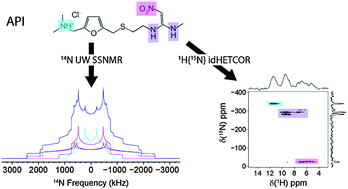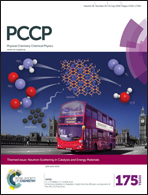Natural abundance 14N and 15N solid-state NMR of pharmaceuticals and their polymorphs†
Abstract
14N ultra-wideline (UW), 1H{15N} indirectly-detected HETCOR (idHETCOR) and 15N dynamic nuclear polarization (DNP) solid-state NMR (SSNMR) experiments, in combination with plane-wave density functional theory (DFT) calculations of 14N EFG tensors, were utilized to characterize a series of nitrogen-containing active pharmaceutical ingredients (APIs), including HCl salts of scopolamine, alprenolol, isoprenaline, acebutolol, dibucaine, nicardipine, and ranitidine. A case study applying these methods for the differentiation of polymorphs of bupivacaine HCl is also presented. All experiments were conducted upon samples with naturally-abundant nitrogen isotopes. For most of the APIs, it was possible to acquire frequency-stepped UW 14N SSNMR spectra of stationary samples, which display powder patterns corresponding to pseudo-tetrahedral (i.e., RR′R′′NH+ and RR′NH2+) or other (i.e., RNH2 and RNO2) nitrogen environments. Directly-excited 14N NMR spectra were acquired using the WURST-CPMG pulse sequence, which incorporates WURST (wideband, uniform rate, and smooth truncation) pulses and a CPMG (Carr-Purcell Meiboom-Gill) refocusing protocol. In certain cases, spectra were acquired using 1H → 14N broadband cross-polarization, via the BRAIN-CP (broadband adiabatic inversion – cross polarization) pulse sequence. These spectra provide 14N electric field gradient (EFG) tensor parameters and orientations that are particularly sensitive to variations in local structure and intermolecular hydrogen-bonding interactions. The 1H{15N} idHETCOR spectra, acquired under conditions of fast magic-angle spinning (MAS), used CP transfers to provide 1H–15N chemical shift correlations for all nitrogen environments, except for two sites in acebutolol and nicardipine. One of these two sites (RR′NH2+ in acebutolol) was successfully detected using the DNP-enhanced 15N{1H} CP/MAS measurement, and one (RNO2 in nicardipine) remained elusive due to the absence of nearby protons. This exploratory study suggests that this combination of techniques has great potential for the characterization of solid APIs and numerous other organic, biological, and inorganic systems.


 Please wait while we load your content...
Please wait while we load your content...